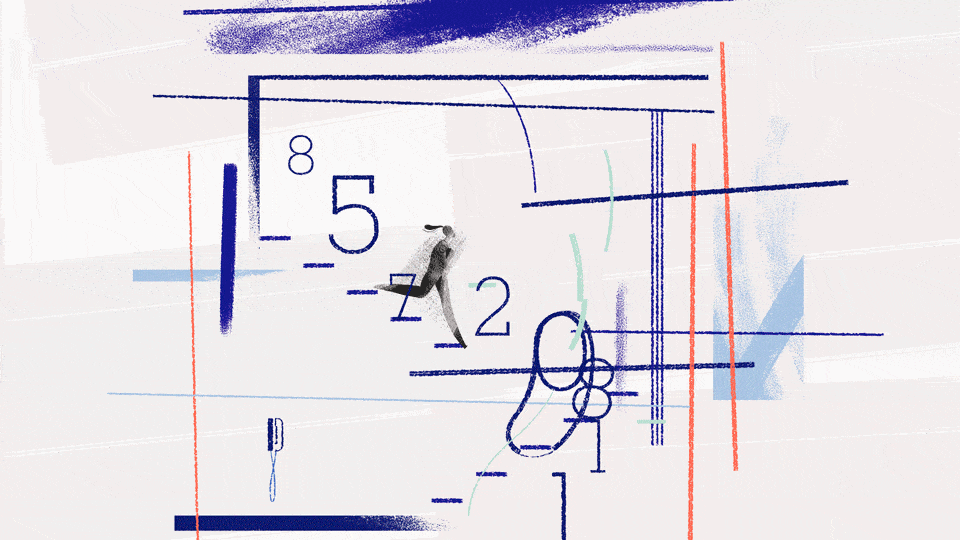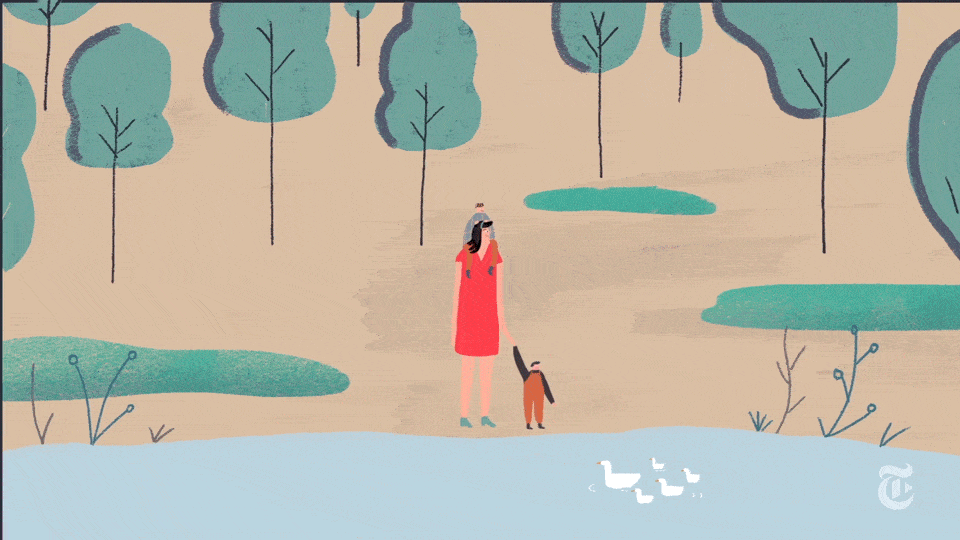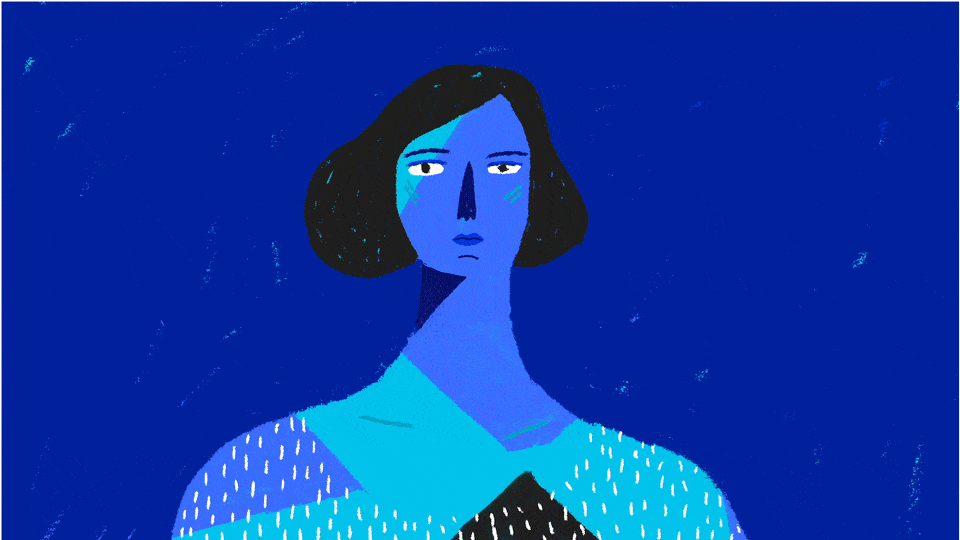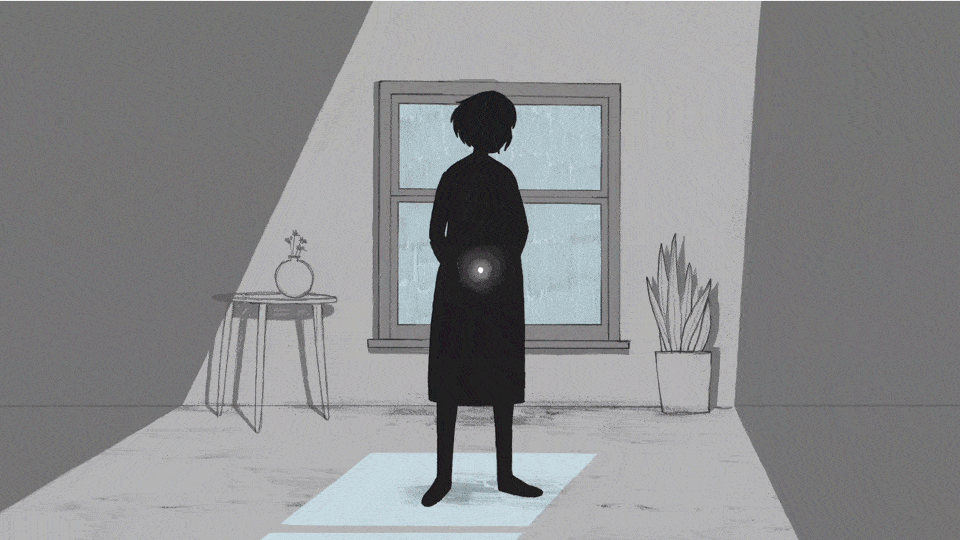The visual essay has become quite the popular medium within the world of animation. As we touched on in the last post, the CNN Coloscrope series has brought some of the best talents to the plate and produced work that can rival most big-budget commercial productions. It’s hard to pinpoint when this format started, but it’s continued to grow. The New York Times had the successful Modern Love series, The California Sunday magazine had the ever popular California Inspires Me series, and the aforementioned CNN Colorscope series, just to name a few. Now, The New York Times is back with the Conception series.
We spoke with the directors of this new series: Moth Studio, Amelia Giller, Hannah Jacobs, Joanna Neborsky, Jordan Bruner, and Sam Ballardini. Below you can find a mini questionnaire with each to find out more about what went into their terrific contributions to the series.
Moth Studio
Responses by Marie-Margaux Tsakiri-Scanatovits
The stories told cover some heavy topics, what was it like working on this series?
We were given the first story of the series, Jen and Catie’s, but we were not aware of the other stories until they all launched last month. It was incredibly interesting to watch them all and see the variety of topics that they all covered. Our story talks about infertility and PCOS (Polycystic Ovarian Syndrome), a subject that I was personally interested in portraying and raising awareness on, but it is ultimately about the power of sisterhood and love. Jen and Catie’s story is fabulously touching, moving and inspiring, making it even more imperative for us to treat it with the utmost care, respect and sensitivity that it required and deserved.
As a studio, we have previously taken on several projects that deal with sensitive and/or difficult issues. Our NSPCC films about child abuse and teenage suicide, for example, were an intrinsic experience for us to learn how to best approach such stories and how to respect the victims. As a result, we embrace each new script of a similar nature as a challenge to tell someone’s personal story in the most appropriate and dutiful way.
Can you tell us a bit about your process?
When Margaret Williams was still editing the interview, we asked her for the original 3-hour recording, just so that we could get a sense of the sisters and their personalities before starting to design. I personally find it impossible to come up with a style before hearing someone’s voice, as it says so much about how the design and the animation style should be treated.
Upon receiving the final edit of the interview, we worked on quick thumboards, most of which became the final shots we used in the film.
We made a word doc which we shared with Margaret and had a bit of a back and forth to ensure we were hitting all the points that needed to be addressed while finding creative solutions for points that needed to be argued. That initial doc included our creative approach, notes on the script we received and finally a sentence by sentence breakdown with a visual description and some alternatives.
The paragraphs on the creative approach were the most important for the NYT team to get a sense of our vision for the story, including all the symbolism and narrative threads that we wanted to employ in order to illustrate it.
The boards were done cleanly to keep the design process faster, and once the design was nailed we started doing tests to see how it could be translated effectively into animation.
Finally, we brought Ally Mobbs and Pierre O’Reilly (sound designer and composer) on board in the animatic stage and encouraged a creative freedom for both whilst maintaining a dialogue between them. Pierre also went on to make the music for the entire series using only female vocals and thus tied to the general theme of the project.
Finally, what is next for you?
We are in the final week of production of a wonderful, colorful, super fun film for a science platform, which we will be hopefully launching soon. Our studio is covered in poska pens and acetates and we are having a blast animating it! We are also making some little fully 3D films for a commercial client, and we’re developing a long-form project further as we gear up for pitching forum season. We have all our fingers crossed!

Amelia Giller
The stories told cover some heavy topics, what was it like working on this series?
Although the topic is heavy, it reminded me that every single woman makes these big, life-changing decisions about having children. Our narratives are unique to each of us, but ultimately this series showed that we’re all tied together by our stories: of fertility, our relationships with our mothers and daughters, and our decisions to have (or not have) children. Cassandra’s story was so complicated and rich. The team at NYTimes sent me a lot of their research material – photos, interviews, excerpts of writing from Cassandra herself. I felt lucky to be given the chance to really delve deep into her personal history. The final audio cut left out a lot more of her story, and so it was up to me to convey some of her family’s struggles through imagery. Ultimately, I hope that I conveyed the joy in Cassandra’s decision to have her son.
Can you tell us a bit about your process?
First, I sorted through all of the amazing material I got from the NYTimes and began character designing (my favorite part). I tried to represent Cassandra as she truly is. From there, I explored some style frames. (see attached) There was back and forth about including text frames, but ultimately we decided not to. The process was originally supposed to be two months but I also work full time (as Sr. AD at Buck), and was very happy to be granted an additional month to flesh things out. I had amazing help from Eli Guillou who did some of the mograph shots and Rasmus Bak who added texture and a lot of the camera work. This is the first film I’ve made since I finished my MFA thesis film, “Tigress”, and I learned a lot about what it means to make films while you working full-time. With every film I make, I learn a million things, and “Cassandra” was no exception.
Finally, what is next for you?
I never know exactly what is next! At Buck, I’m ADing a team that is working on an enormous redesign project. It’s been really fun, and my team is fantastic. A personal project that I’ve been having a great time with on the side is illustrating for Intercom’s blog. It’s so cool to be among other great artists (Jimmy Simpson, Karl-Joel Larsson, Molly Mendoza) on the site. And, of course, we’ve always got new illustrations and exciting things happening with my collective, Get It Girl!

Hannah Jacobs
The stories told cover some heavy topics, what was it like working on this series?
I feel incredibly honoured to be a part of such a unique series that has created the opportunity to hear from different women’s perspective on motherhood that might not otherwise have been heard. It was a real privilege to share the experience of Gabrielle, who transitioned from male to female and how that affected her experience of motherhood. As a director, I wanted to make sure that I created a visually rich and moving film, without detracting from Gabrielle’s story at all. Like all the films in the series, this was an opportunity to tell an alternate story of motherhood to an audience that might not have any previous understanding of that world, or equally the opportunity to share a story that resonates with people and might help them to feel less isolated in their own experience. That felt like a big responsibility but also an enormous honour.
Can you tell us a bit about your process?
My process started with a flurry of ideas as I listened to the voice over, scribbling down thumbnail sketches and ideas for different scenes on paper. I was given a lot of creative control by The New York Times which was really great and meant I could spend some time figuring out a storyboard that I was happy with and in my own style of animation. I wanted to create a film that focused on the emotional journey of Gabrielle and so decided to have minimal cuts in it and make use mostly of flowing transitions to create a sense of emotional and physical fluidity. This in turn allowed for a more abstract approach to the visuals, which I think helped in my mission not to detract too much from the story itself. The animation itself is all hand drawn digitally, mostly in Photoshop and then composited in After Effects.
Finally, what is next for you?
I’m currently working on a new animation commission, and have just finished the pitch for a new animated kids series with two female protagonists (if anyone wants to pick it up!) with co-creator and writer/director Alice Trueman. I’ve also started work on a brand new short film that I’m hoping to start animating in the Summer.

Joanna Neborsky
The stories told cover some heavy topics, what was it like working on this series?
This is, by pure accident, the second animation about motherhood I’ve done for the New York Times. (Here’s the first, from 2013, for their Modern Love column.) Sadly, it’s the first animation about motherhood I’ve done for the New York Times without a mother to kvell excitedly about my doing an animation for the New York Times. The melancholy of this narration felt true to my current feelings about moms – having had one, now not having one. (My mom died in 2015.) But I should say the animation is very much not my own story. It is Marie’s; I admire her bravery in describing an experience of motherhood filled with regret and ambivalence, which many moms feel, but which is nearly taboo to acknowledge in our culture. Seeing some of the reaction online to this particular installment of the series, I’m reminded of how lousy it is to be a Woman Online, how merely describing one’s interior life and complicated circumstances opens you up to a chorus of infallible people telling you what you’ve done wrong in life. But that’s why I’m glad these animations exist in a series; together they form a rebuttal to the idea that motherhood is just this fixed beautiful perfect natural summit of a woman’s life.
Can you tell us a bit about your process?
I work principally as an illustrator. As an animator I’m self-taught and use the most painstaking, long-winded, industry-inappropriate methods, which means that all the animations I’ve done before this one have mowed down my brain and body, and taken way too long. Because this project was massive and the turnaround time so swift, I sought help in the form of Caitlin Craggs, an accomplished animator in our own right, who took all the compositions I gave her and made them move in the ways I instructed. I have a massive archive of magazine and Xerox cutouts that I scan (supplemented, on this project, with excerpts from vintage pregnancy books) and combine with hand-drawn elements to make the frames. Construction paper, pastels, pencil, ink, the works….
Finally, what is next for you?
You tell me! I’m open for biz.

Jordan Bruner
The stories told cover some heavy topics, what was it like working on this series?
It was definitely challenging at times to come up with visual metaphors for this story, and we went through a few rounds of storyboards that become more abstracted in every round. The visual motifs that kept coming back were sinking and breaking apart to represent this fragmented feeling.
Can you tell us a bit about your process?
The film was created with Photoshop and After Effects, with a combination of frame by frame animation in Photoshop and comping in AE. I initially wanted to create all of the animation on my own to connect to the intimacy of the story, but this became a little overwhelming within the last few days of the project, and Barry Bruner and Zack Williams helped out with coloring and animating the belt scene.
Finally, what is next for you?
I’m currently working on a children’s book and trying to focus on personal projects as much as possible this year.

Sam Ballardini
The stories told cover some heavy topics, what was it like working on this series?
It was truly rewarding to be trusted with Laurin and Danny’s story, and I just wanted to do justice to Laurin’s words. I found their story both heartbreaking and heartwarming in turn, and I hope there’s something everyone can take from it about what it means to love and support unconditionally. Working on the project was a real whirlwind, and the team at NYT was a pleasure to collaborate with. I’m honored to be a part of this project, alongside animators whose work I have admired for a long time.
Can you tell us a bit about your process?
I had 8 weeks from the time I was given the script to conceptualize and complete the project. The biggest challenge was creating a style that was simple enough to cover 4+ minutes of animation (with me as the only artist), but detailed enough to convey emotion in the characters, and style-wise I still wanted each shot to have pockets of detail. My style tends to be more realistic and detailed, so paring it down was a real challenge. Once the look & feel was approved, I got to work on hand drawing my backgrounds and environmental elements. It was important for the piece to have a textural, hand-done feel so I opted to draw the environmental elements on paper, scan them, then finish digitally. All of the cel animation was done in Adobe Photoshop (I’m a big fan of AnimDessin for Photoshop animation), and I composited in After Effects.
Finally, what is next for you?
I generally work on designing for commercials, and I hope this piece opens the doors to some longer format projects. In the meantime, I’m finishing up a personal short (teaser: https://vimeo.com/169691740 ) which I hope to have done before summer, and freelancing around NYC.







